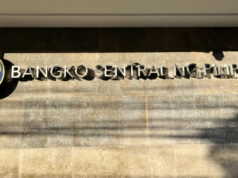Moody’s sees economic growth likely muted in Q2
THE ECONOMY likely grew at a muted pace this quarter, a senior executive of Moody’s Investors Service said on Thursday.
Moody’s also said it still sees Philippine gross domestic product growth this year at six percent — a projection first given in May that was down from 6.2% previously — saying that the government would be hard-put to catch up in its spending plan, especially for infrastructure, after the four-month delay in enactment of the 2019 national budget, which had also been slashed by P95.3 billion to P3.662 trillion.
“The government’s intention to catch up, it will be very challenging to fully execute that budget,” Christian De Guzman, Moody’s vice-president and senior credit officer, told a media briefing on Thursday.
“I don’t think you should be excited about Q2. I mean because of the budget impasse, we’ve already lost four months and because of the electoral ban [on public works ahead of the May 13 mid-term polls], you have another month. Our expectations for Q2 are not very great either. And you also have to add to that the external developments which continue to weigh on exports,” he explained, adding that for the full year, “We think that the six percent estimate that we forecast for 2019 remains intact.”
The Philippine Statistics Authority is scheduled to report second-quarter GDP data on Aug. 8.
Moody’s projection is at the floor of the government’s 6-7% target for 2019 and would be even slower than the four-year-low 6.2% in 2018.
For Socioeconomic Planning Secretary Ernesto M. Pernia, however, GDP this year could still grow faster than in 2018’s four-year-low 6.2%.
“I would say 6.5% is attainable,” Mr. Pernia told reporters at the sidelines of the 27th Metro Manila Business Conference at The Manila Hotel, citing as growth drivers election-related expenditures and consumer spending — amid generally slower inflation — that contributes nearly 70% to national output.
Mr. Pernia added that second-quarter growth is “not as strong as the third quarter would be.”
To government’s credit, Mr. De Guzman noted, “reform momentum ahead of the… mid-term elections in the Philippines was actually comparatively strong”, citing measures fortifying the central bank, introducing universal health care and tax reform, among others.
“When we look at what had happened elsewhere in the region, where they also had… elections — for example in Indonesia — you could say that the reform momentum is paused for… maybe more than a year ahead of those elections…” Mr. De Guzman noted.
“The Philippines actually developed because they were able to pass very important reforms, even just months ahead of the elections.”
Zeroing in on tax reforms, he said that improving revenue collection should help spur state spending and, in turn, economic growth further.
“We will see the very low Q1 outturn as somethat ephemeral, somewhat temporary. We still see positive elements coming from imposition of reforms… Government revenues continue to be quite strong and we can achieve that through tax reforms,” Mr. De Guzman said.
Latest available official data from the Bureau of the Treasury showed state revenue collections growing by 10.7% to P1.314 trillion in the five months to May from P1.186 trillion a year ago, although the government spent 0.8% less at P1.315 trillion from P1.325 trillion in the same comparative periods due to the four-month delay in national budget enactment. Year-to-date, the National Government’s fiscal deficit was slashed by 99.4% to P809 million from P138.7 billion in 2018’s first five months.
Mr. De Guzman also said in the same briefing that while the Philippines is “not immune” to the impact of the simmering Sino-US trade row, “[t]he Philippines, being less export dependent than a lot of other Asian countries is well positioned to weather the storm… somewhat.” — R. J. N. Ignacio



